The Most Flattering Hair Colors for a True Autumn Palette

Key Takeaways
- True autumn hair loves warm undertones and deep, earthy richness. Seek out golden, copper and red notes and steer clear of ashy or icy shades to maintain your color in tune with warm skin tones.
- Select rich, intense browns and soft, sun-kissed shades for a chic, rustic feel. Chocolate, chestnut, auburn and honey blonde are good places to begin for most true autumn complexions.
- Create natural dimension with delicate highlights and lowlights in the same warm family. Mix caramel, toffee and golden threads for movement with no harsh contrast.
- Try your color in several lighting before you commit. Verify tones in daylight for accuracy, then tone down makeup or wardrobe under indoor lighting to keep it warm.
- Coordinate your beauty to the palette for complete symmetry. Wear gold or bronze jewelry, warm peachy blush and golden highlights for makeup, and earthy colors like olive, mustard, and burnt orange for clothing.
- Forget the folklore–dive into the entire spectrum of fall hues. Warm blondes, browns and reds all fit in, and soft highlights are embraced — as long as they remain warm and subtle as well.
💫 Learn Seasonal Analysis
Ready to explore the complete seasonal color analysis system? Discover how to identify your seasonal type and unlock the perfect color palette that enhances your natural beauty.
Learn Seasonal Analysis →True autumn hair colors are warm and rich with golden or copper bases. Imagine soft ginger, spicy cinnamon brown, golden chestnut and deep honey blonde.
Warm or neutral-gold undertone skin is a great match, and eye colors such as hazel, green or warm brown pop alongside these hues. To keep it natural, opt for low-contrast blends and soft highlights.
For care, sulfate-free shampoo and heat ≤180 °C. Ahead, discover shade charts, undertone hints, and salon-safe guides.
📚 Recent Articles
What defines true autumn hair colors?
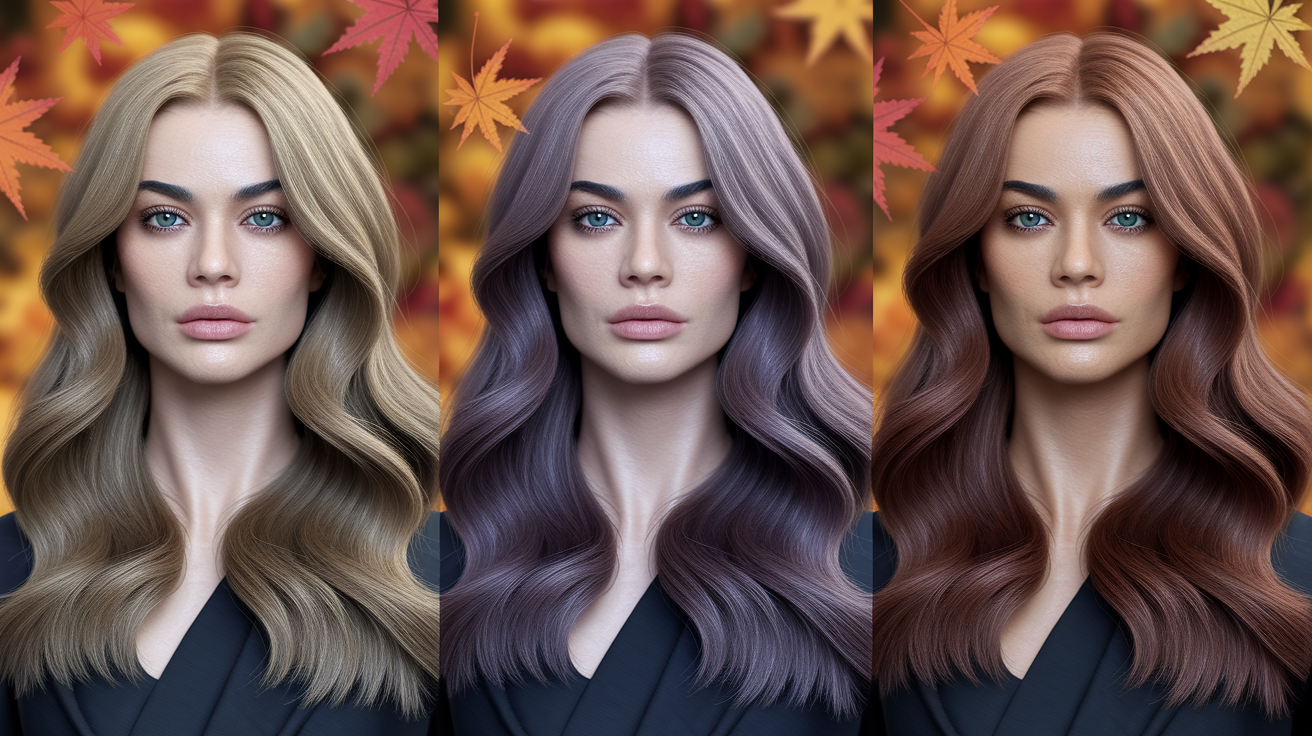
True autumn hair skews warm, golden, and earthy. We're talking deep, velvety browns, toasted reds and sun-drenched golds that mimic the colors of fallen leaves. The palette mixes muted softness with jewel-like depths, complementing warm skin undertones and low-contrast features.
What sets it apart is its glow: multidimensional warmth without icy sparks or neon punch.
1. The warm undertone
Warm undertones are what make the look. Golden, copper, and soft reddish notes create that signature autumn heat that suits warm skin. Chestnut Brown, Warm Golden Brown and Deep Auburn are all shades that hold this silent flame.
Copper and Cinnamon Brown and Auburn sit well too, giving that warm yet grounded effect.
Byasle ashy blondes, icy browns and cool black. They gray out the face and mute the eyes. Warm tones reflect the light back onto the skin and add a healthy lit-from-within glow – particularly for the warmest autumns.
- Warm undertones: golden, honey, copper, cinnamon, amber; soft illumination) skin appears more even; eyes twinkle
- Cool undertones: ash, blue-black, icy beige; flat cast; skin turns sallow; eyes lose dimension.
2. The rich depth
Depth is what counts. What makes authentic autumn hair colors pop? Chocolate Brown (Level 3–5), Chestnut and Espresso add a weight that feels cozy, not heavy. They create a firm foundation for warmth to appear.
Medium to dark browns, however, anchor the palette, keeping it grounded. Lighter, cooler browns don't quite nail it. Very dark, cool black do dominate.
Incorporate rich variations—mahogany lowlights, warm caramel threads, or a copper glaze—to add movement. Examples that fit: Chocolate Brown, Chestnut Brown, Mahogany, Warm Golden Brown, Deep Auburn.
Throw in a gentle copper melt at the tips for a subtle mood swing.
3. The muted softness
What are the true autumn hair colors? Go with gentle, low-chroma tones instead of pointy or high-chroma colors. This keeps hair in harmony with warm skin and produces a peaceful, chic frame for the face.
Bright reds or neon coppers or ultra-vivid golds can look brash. Muted warmth mixes. It doesn't holler.
| Muted vs. Vivid to avoid. | — | — |
|---|---|---|
| Cinnamon Brown | Neon Orange | |
| Soft Copper (L5–6) | Fire-Engine Red | |
| Warm Golden Brown (4 – 6) | LEMON YELLOW BLONDE | |
| Rich Chocolate (Level 3–5) | Blue-Black |
4. The natural dimension
Go for hues that resonate with autumn fields and leaves—strata of warmth that transform in the light. Blend within one warm family: Chocolate base with Cinnamon Brown ribbons, or Deep Auburn with soft copper peeks.
Keep the contrast low so nothing looks stripy. Subtle highlights and lowlights are best.
Consider balayage with warm honey or golden highlights for a sunkissed effect. A copper glaze can pull everything together… shine without cooler sheen.
Dimensional color keeps it together by allowing gold undertones to shine through the entire head. The effect is lush, luminous and undeniably the coziest autumn color spectrum, with copper and auburn undertones that illuminate rather than burn.
The best hair color for true autumn
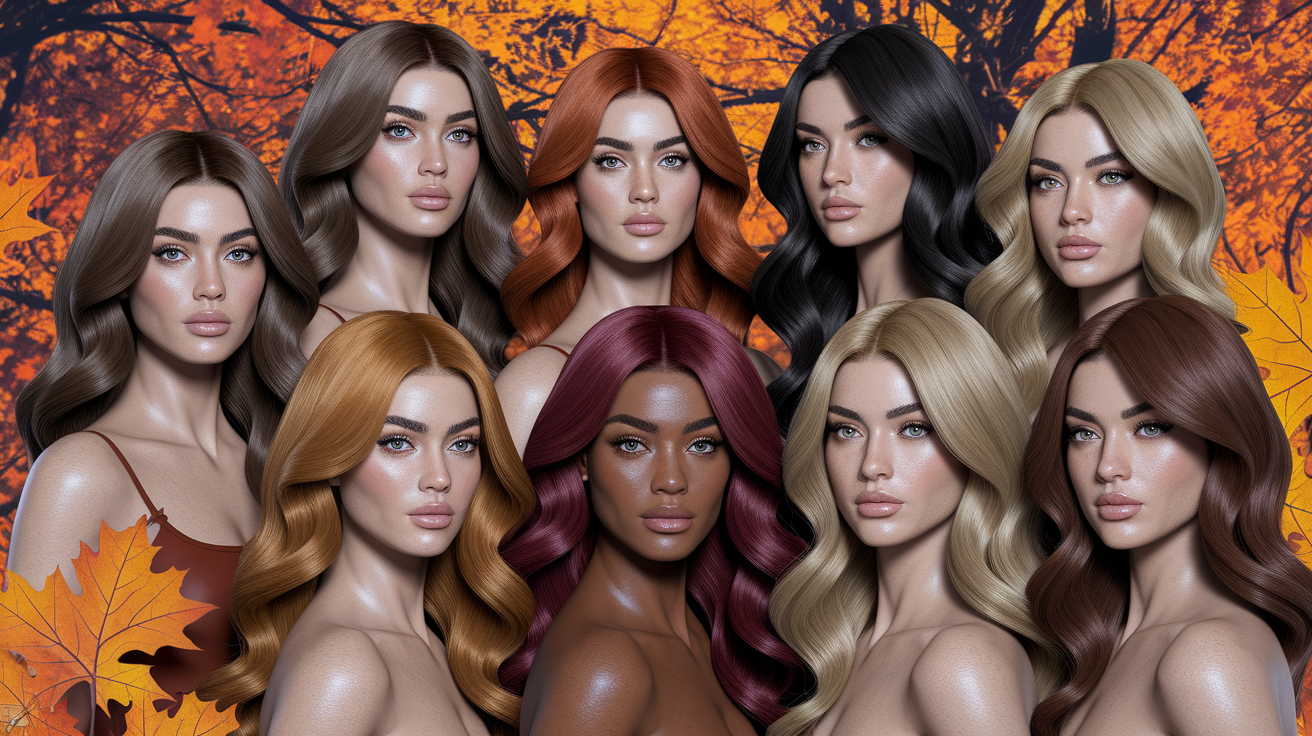
TRUE AUTUMN HAIR COLORS fall into the warm, earthy spectrum, showcasing vibrant hues like rich browns, spicy reds, and golden blondes with depth. Aim for a level 5–8 to maintain balance. It's essential to match warm hair colors to warm skin undertones and true autumn eyes that read amber, hazel, green, or warm brown. Avoid frosty blondes, ashy tones, and blue-black, as they mute the radiance.
- Chocolate brown: deep, soft, and warm; adds richness without heaviness.
- Chestnut: brown with red-gold threads that light up hazel and green eyes.
- Toffee brown: medium, golden-leaning; great for softer complexions.
- Cinnamon brown: a spicy brown-red that echoes autumn leaves.
- Auburn: warm red-brown that flatters golden-beige skin.
- Copper: vivid but earthy when kept in the level 6–7 range.
- Honey blonde: sunlit gold that keeps warmth without washing out.
- Golden blonde: luminous and full-bodied; not pale or icy.
Rich browns
Chocolate, chestnut and toffee brown add warmth and serene depth. Chocolate brown adds dimension while remaining soft, a staple for True Autumns desiring polish without harsh contrast. Chestnut reads vibrant on warm skin and complements hazel eyes beautifully.
Toffee brown flatters lighter warm skin tones and complements golden freckles. These browns reverberate the palette's earthy foundation, so they harmonize with golden undertones in skin and eyes. Sprinkle in fine caramel or subdued gold highlights to pick up motion, particularly near the face, but never more than 2 levels lighter to prevent striping.
Espresso brown is very chic but tips too dark and cool on most True Autumns; Dark Autumn suits it better. Shoot for 5–7, stay away from near black.
Warm reds
Auburn, cinnamon and copper reflect fall light. Auburn provides a perfectly balanced red-brown that compliments warm beige to golden olive interior tones. Cinnamon delivers that spicy kick that makes amber flecks in eyes pop.
Avoid blue-based reds and cherries; they go harsh or magenta on warm skin. Mix in golden or brown lowlights through copper to anchor vibrancy and maintain wearability.
Most flattering picks: soft copper (level 6–7), cinnamon auburn, rusted auburn, and warm mahogany with golden threads.
Golden blondes
Go for honey and golden blondes, not ash or platinum. Think sun-kissed, toasted gold versus a pale, cool tone. Maintain levels 7–8 so the color doesn't wash out the face.
Soft caramel/toffee ribbons lend depth and reflect the True **Autumn palette**. Golden blondes glow next to warm skin. Cooler blondes can appear flat, even gray-leaning.
Next to one another, honey blonde shines bright and warm while ashy blonde sucks out warmth and intensifies shadows.
How light changes your hair's appearance
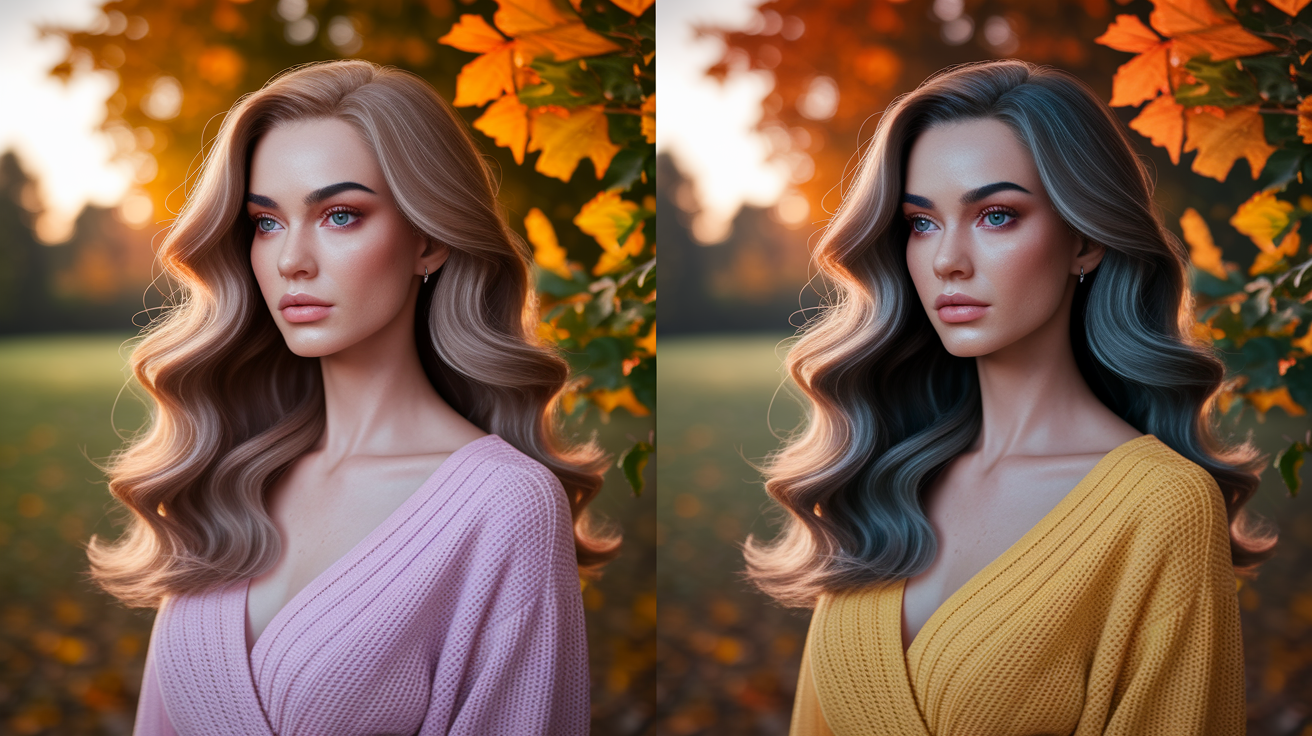
Light changes the way true autumn colors register—color, dimension, and glow. It can warm or cool, mute or sharpen your autumn color season, steering makeup, wardrobe, and photos to maintain a deep and authentic look.
Natural daylight
Sunlight brings out the gold and red tones that lurk within genuine autumn hair. Color can look vivacious and bright in the morning, and late afternoon sun can make it look deeper and richer. A lot of us have observed our hair appears more alive and dimensional outdoors on a sunny day, and texture appears silkier due to the fact that gentle natural light amplifies shine.
Anticipate warmer more vibrant hair in outdoor light. True tones show up best here, and hair tends to look darker or richer because daylight exposes dimension, not just reflective shine. Direct noon sun can wash out texture, but shade or light cloud cover provides an even reading.
Daylight can be used to divine your true tone before grand decisions. Stand by a window looking at open sky, or slip outside and see in indirect sun. This provides a true view of undertone and assists you in selecting makeup – warm peach or terracotta tends to go nicely.
Do remember to check any new color in natural light before you commit! Go take a mirror outside, check out your roots and mids, then take a photo in the shade and one in open light, so you can compare.
Indoor lighting
Indoor light will mute that autumn richness. Fluorescent and a few cool LEDs don't quite emphasize the blue, making warm hair look brassy or slightly orange. Texture changes — hard overhead light can cause hair to appear dull and/or frizzy, while soft lamps smooth everything out.
Fix your makeup and clothes for the room. Cool light means you should lean into neutral brown shadow and a soft rust lip so that warmth feels curated. In warm rooms, golden jewelry and camel or olive clothing reverberate your undertone without overload.
Experiment with bulb tests at home! Warm bulbs enhance golden brown or honey with a sun-kissed glow, while cool bulbs flatter cool undertones best. Do keep a mirror near a window for some indoor bias-balance and a truer color read.
Seasonal shifts
Sun, humidity and dry air affect how your fall hair looks. Summer sun may lighten and pull warmth brighter. Winter light can sometimes make shades appear deeper and a bit flatter.
Guard color when seasons swing. UV shields for summer, richer masks for winter, and lower heat styling all year round. A clear or warm glaze will bring back depth in between salon appointments.
Touch up with gloss or toner as the days of light shift. It keeps undertones consistent and assists with wardrobe planning.
- More sun exposure: brightness rises; utilize UV spray and hats.
- Dry winter air: dullness climbs. Add hydrating masks and oils.
- Pool or sea: warmth can skew brassy. Rinse then chelating wash.
- Shorter days: color looks deeper. Add soft highlights or a warm glaze.
- Photo tips: shoot in open shade in summer, near a window in the winter.
The science behind your autumn hair
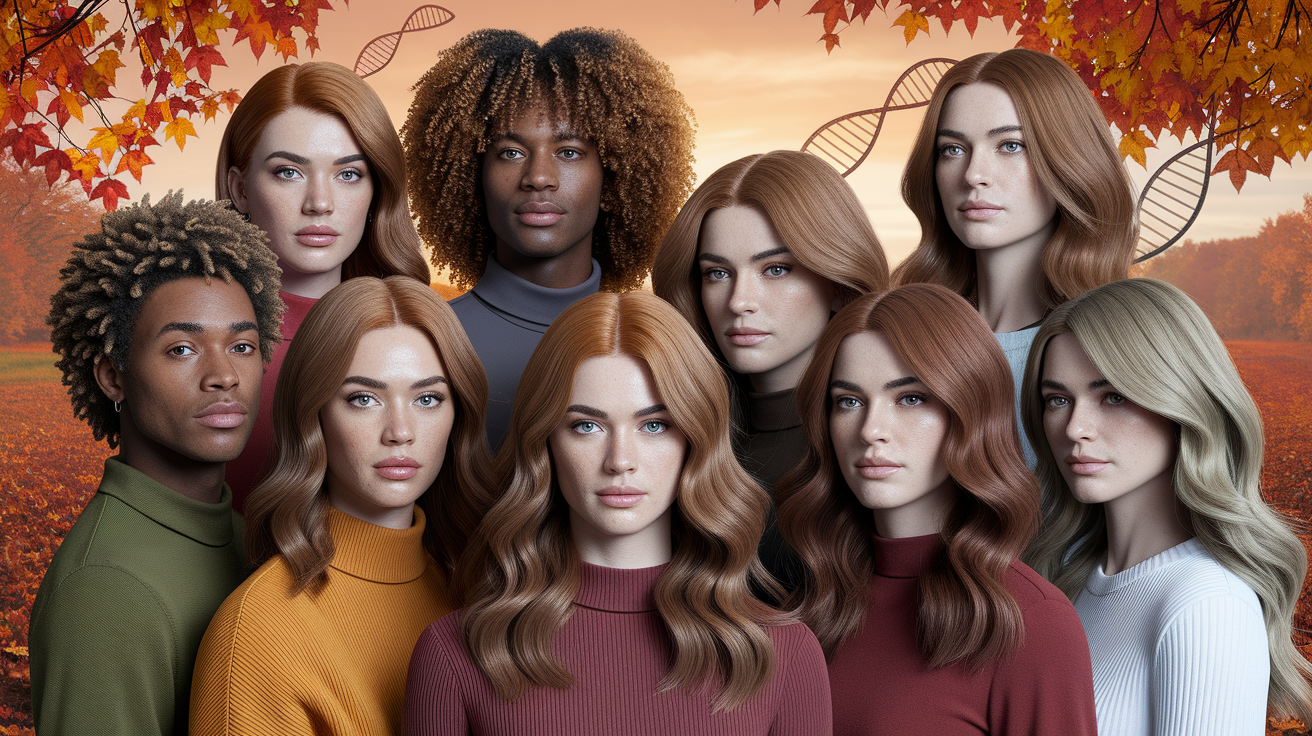
Genuine autumn hair 'reads' warm to the eye due to the collaboration of pigment, light, and genetics, creating a true autumn colour palette. Think golden undertones and low-contrast depth, with tones that linger around 3000–4000 K—warmer than neutral daylight at 5500 K. These autumn colors tend to appear deeper in diffused light and more copper in the sun, indicating that both melanin blend and light bounce determine what we witness.
Genetic markers
A few genes control warm brown, red, and golden pigments, which are essential in creating the autumn color season. MC1R tips production toward pheomelanin, the source of copper, amber, and auburn hues, contributing to the vibrant hues seen in the true autumn palette. Variants in ASIP and TYRP1 determine how much eumelanin darkens the ground, while OCA2 and SLC24A4 adjust total pigment volume, pushing hair toward golden or chestnut, enhancing the overall autumn colours.
Some backgrounds have more of these variants than others, particularly throughout much of Western and Northern Europe, the Caucasus, and some West Asian populations. These regions often produce true autumn individuals, where warm tones are seen globally in many admixtures. Family patterns often tell the story: two parents with MC1R variants raise the odds of auburn children; a TYRP1-heavy lineage tends to produce dark golden brown, which fits perfectly into the autumn color palette.
Useful markers to watch include MC1R (R151C, R160W, D294H), ASIP promoter changes, and TYRP1 coding variants. While no individual indicator 'validates' real fall, constellations forecast mild, low-ash results among brothers and sisters, showcasing the beauty of the soft autumn complexion and the rich hair colors that define this season.
Melanin's role
Eumelanin gives hair that deep, shadowed look — more of it equates to the richer browns common among true autumns. Pheomelanin contributes the gold, copper and rust shine. The warm appearance results from an increased pheomelanin proportion layered over medium-to-high eumelanin, so the foundation remains grounded while highlights shimmer amber.
Dense melanin granules absorb blue light and reflect red–yellow wavelengths, so strands look warm even in shadow. You may observe seasonal shifts in some autumns—some slight summer lightening or winter darkening—because UV exposure and hormone cycles tweak follicle output at the margin.
Compared with other seasons, winters hold high eumelanin with cool ash reflect. Springs exhibit lighter pigment with radiant, clear gold. Summers lean low contrast and cooler beige. Autumns are warmest, with that gorgeous, multidimensional, earthy depth.
Historical context
Warm hair shades show up in Bronze Age Europe to Silk Road mug shots, with copper and chestnut locks prevalent where commerce mingled peoples. Medieval tapestries and Renaissance glazes preferred sienna and umber backgrounds, which turned flaxen locks radiant.
In a few 20th-century flashes—Arts and Crafts, 1970s eco-chic, the recent slow-fashion movement—earth palettes propelled cinnamon and tobacco hues to the front again.
Style history also links autumn hair with certain pairings: warm neutrals, deep berry, and rich earth tones. Famous names that come to mind are the red-headed Pre-Raphaelite sirens, Dante Gabriel Rossetti's models, and contemporary ones with chestnut-gold hair that reads golden on neutral backgrounds.
Beyond hair: creating total harmony
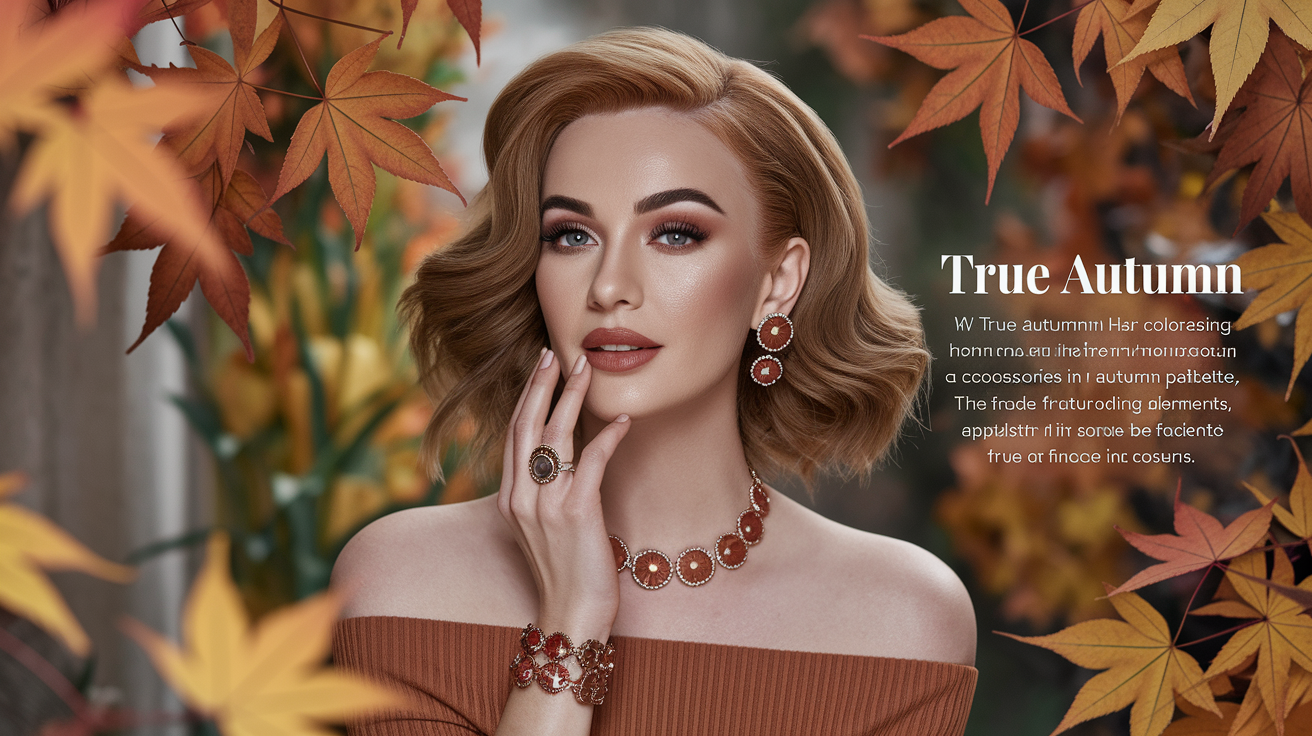
Real fall happens when your hair, skin, eyes, and clothes all reflect the same cozy, earthy tale of true autumn colors. It's about total harmony and how every decision—color, texture, pattern—supports one another. With a warm color palette, the look remains sleek, ensuring that big color changes don't disrupt equilibrium.
Makeup palettes
Warm-toned makeup connects true autumn hair to the face. Think soft browns, warm taupes, camel and russet on eyes. Select peach or apricot or terracotta for cheeks. Opt for golden highlighter over an icy shimmer – think candlelight, not strobe.
Pass on cool or neon shades. Blue-based reds, fuschia, icy pink and charcoal gray tone down autumnal undertones and can appear flat. Even timeless black liner can seem harsh. Deep espresso or warm moss provides gentler contrast.
Lip color thrives in earthy reds and oranges: brick, cinnamon, rust, pumpkin spice, warm terracotta, and muted coral. Eyeshadow works beautifully in amber, olive, bronze and chestnuts. These reflect the hair's golden warmth and make green, hazel, or warm brown eyes sparkle.
Sample palette: eyes—olive, antique gold, bronze, chestnut; liner—deep espresso; blush—apricot or burnt peach; highlight—soft gold; lips—brick red for bold days, cinnamon nude for daily wear.
Jewelry metals
Gold and bronze and copper sit best against true autumn hair and skin, adding a mellow glow that feels like you, not on you. Silver and platinum, meanwhile, can get sharp and cold, which distracts attention and mutes warmth, even with a nice foundation color match.
Mix texture for depth. Matte, brushed, hammered and lightly patinated finishes merge with fall textiles such as suede and tweed without shine. High polish, while wonderful in small doses, should share space with softer surfaces.
Best finishes:
- Brushed yellow gold (14–18K)
- Hammered bronze
- Antiqued brass
- Rose gold with low pink
- Burnished copper
- Gold vermeil with matte seal
Wardrobe colors
Build with earthy cores: olive green, camel, mustard gold, burnt orange, warm chocolate, and rust. These connect hair and skin so the entire look feels serene and luxe.
Accent with teal, pumpkin, deep turquoise, paprika, moss and warm mahogany. Sprinkle them into scarves, belts or a soft knit. Pure white, black, and icy pastels disrupt the line and can wash out warm undertones. Try cream, deep navy-green, or espresso instead.
Choose textures with weight: wool, suede, leather, corduroy. Patterns work when they're medium to small and tightly packed—like houndstooth, tight florals, or check—so color remains the anthem.
| Category | Recommended colors |
|---|---|
| Neutrals | cream, camel, warm taupe, chocolate, olive-drab |
| Core | olive, mustard, rust, burnt orange, terracotta |
| Accents | teal, deep turquoise, pumpkin, paprika, moss |
Checklist:
- Hair stays within warm, rich browns or coppery tones.
- Makeup in peach, rust, gold; avoid cool or neon.
- Metals: gold, bronze, copper; matte or brushed.
- Clothes: earthy cores, warm accents; skip stark black/white.
- Textures with heft; patterns small and dense.
- Check mirror for one warm, unified field.
Common myths about autumn hair
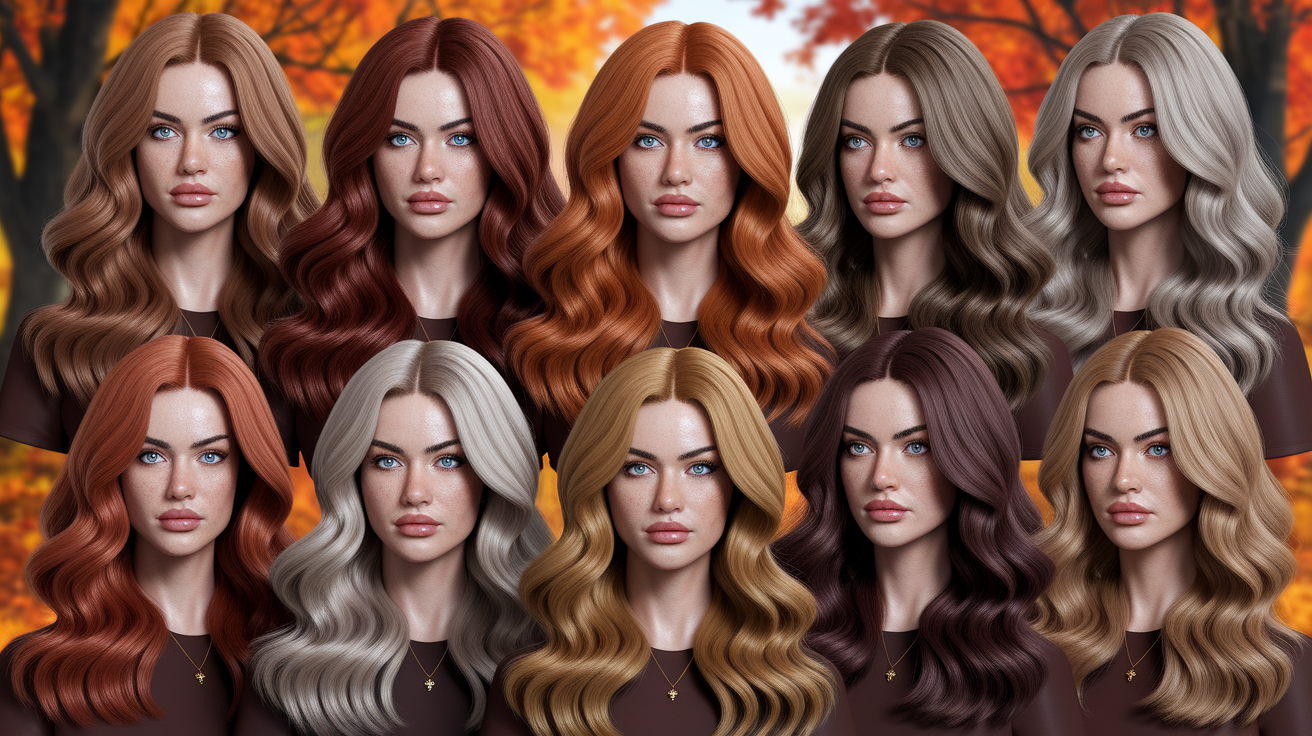
Real autumn hair showcases a broad, warm range of true autumn colors. It features golden, earthy, and spicy tones that vary in depth and undertone, reflecting the vibrant hues of the autumn color season.
- Myth: Autumn hair must be very dark. Fact: Medium to light warm shades thrive in the palette.
- Myth: Only red counts. Fact: Warm browns, golden blondes, and multi-tones are equally autumn.
- Myth: Highlights are off-limits. Fact: Warm, soft highlights add depth when placed well.
- Myth: Static harms hair in fall. Fact: Static is common but not long-term damage.
- Myth: Color fades faster in autumn. Fact: Fading comes from UV, water chemistry, and dye type.
- Fact: Dry air and cold can raise dryness and breakage risk. Care reduces it.
- Fact: Seasonal shedding can occur, but it's not from the cold.
Too dark
Autumn hair, staple read as deep and heavy, runs from warm light brown through rich medium to dark espresso with amber glow. Think honey chestnut, golden oak and tobacco brown. Depth varies, but the common denominator is warmth and muted softness.
Lighter choices worked too. Golden blondes with wheat or butterscotch undertones, warm light browns with soft copper highlights and dark blonde with maple lowlights all fall into true autumn. A caramel root melt on dark blonde holds warmth without weight.
For care, autumn dry air can make ends brittle, and cold air can increase breakage risk. Apply richer conditioner, downshift heat tools, and protect strands outside for any shade of oil to shine glossy and sleek.
Only red
Red and copper, iconic but optional. Most bona fide autumn heads dress in warm browns, golden blondes and bronze blends that read sun kissed rather than ruby red.
Other non-red shades hold on to autumn's magic with their golden undertones and low contrast. A golden mushroom brown with caramel ribbons, a toasted almond blonde, or a cocoa brown with amber sheen all feel grounded and warm.
Examples that are not red:
- Honey blonde, wheat blonde, butterscotch blonde
- Caramel brown, chestnut, cinnamon brown
- Bronze balayage, maple lowlights on dark blonde
Seasonal notes: some people see extra frizz or dryness as humidity drops, and autumn's dry air can worsen dandruff or eczema. Moisture masks do the trick. Color doesn't fade faster because it's fall — pay attention to UV care, gentle washes and dye quality.
No highlights
Highlights only do their job if they remain warm, soft, and blended. Caramel, golden syrup, bronze or light copper micro-foils lift dimension without becoming ashy.
Allow placement to be diffused around the face and mid-lengths, anchored with warm lowlights so no striping occurs. Ditch cool or ash highlights, which mute the golden base and can appear flat.
If the hair is already dry, lighten in increments and add bond care.
Tips to blend well:
- Select 1–2 levels lighter than the base to maintain balance.
- Use fine weaves or babylights; skip stark contrasts.
- Gloss with warm toners to seal tone and amplify shine.
- Keep your hair hydrated. Static zaps in dry, cold air but doesn't do permanent damage.
- Seasonal shedding can occur, but it's not from the cold.
Conclusion
To sum it all up, true autumn hair flourishes in warm light, deep richness and gentle radiance. Think copper, bronze, chestnut and warm gold. Skin appears fresh. Eyes seem bright. Hair feels alive. A little flip can go a long way. A dash of copper in deep brown. A toast glaze on top of blonde. A red-brown melt that brings the heat, not the glare. #trueautumnhair
Real talk from the chair: a client with muted brown went soft copper gold. Her skin glowed. Freckles popped. Not a heavy handed transformation. Just intelligent shade. Light is a big factor. Indoor shade appears intense. Sunlight adds flames. Evening brings Peace + Warmth.
Ready to try out your match! Save some swatch pics, schedule a low-commitment gloss and test drive your features.
Frequently Asked Questions
What defines true autumn hair colors?
True autumn hair colors have warm, rich undertones. Think golden, copper, bronze and warm brown. They shy away from ash and cool tones. The palette mirrors autumn leaves: earthy, deep, and muted-warm. These hues complement warm skin undertones and emphasize golden eye flecks.
What is the best hair color for true autumn?
Our favorites for the true autumn color season are copper, caramel brown, golden chestnut, warm auburn, and bronze. For a lighter option, consider golden honey or warm strawberry blonde! It's best to avoid cool ash browns and blue-black for a more natural look.
How does lighting change true autumn hair?
Warm indoor light enhances the vibrant hues of gold and copper, making them stand out beautifully. However, cool daylight can mute these warm colors or give them a dingy appearance. It's essential to double-check colors in natural daylight and under soft warm light to ensure they fit your true autumn color palette.
What is the science behind autumn hair undertones?
Hair color emits light according to pigments, and true autumn individuals often have hair colors that exhibit rich brown hair shades with red-gold hues. This true autumn color palette features warm undertones that create a harmonious and healthy appearance.
Can cool skin wear true autumn hair colors?
Generally, no. Cool skin can't wear warm hair colors without clashing and making your skin look red or sallow. If you are neutral-cool, opt for softer, muted warms such as golden brown with little copper to complement your true autumn complexion. Always try a semi-permanent gloss first to test harmony.
How do I maintain true autumn hair color?
Choose sulfate-free shampoo, UV protection, and a color-safe conditioner for your true autumn color palette. Spritz warm gloss or toner every 4–6 weeks to revive gold and copper hues, ensuring your autumn season look stays vibrant.
How do I create total harmony beyond hair?
Pair your outfits with warm makeup and a true autumn wardrobe. Opt for golden bronzers, peach or terracotta blush, warm neutral eyes, and earthy lips. Dress in camel, olive, rust, teal, and warm navy to enhance your autumn color season.